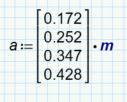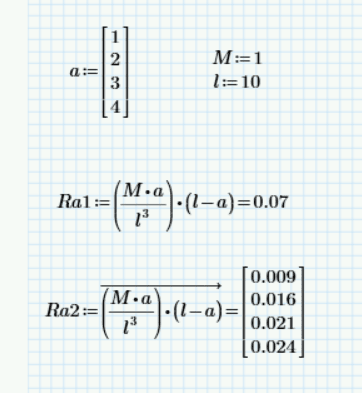Hi,
I was hoping someone may be able to help me with an issue I am encountering using MathCAD Prime 9 relating to the use of arrays to solve an equation which contains a variable which has multiple values.
To provide context, I am looking at analysing a simple beam with fixed ends with a moment which is applied moment at discrete positions alone the beam length. The objective is to determine see how the magnitude of the boundary reaction forces change at each moment position, which is defined by the variable (a), using the following equation taken from Roark's Formulas for Stress and Strain:

As (a) has multiple values I have defined these using an array i.e.

For some reason rather than providing a number of answers for (Ra) in the form of an array for each defined value of (a) the equation returns single scalar number which appears to occur on account of the equation involving the multiplication of the array variable (a). Can anyone advise as to how I can instruct the software to provide an answer in the form of an array for rather than a scalar quantity?
Any advice greatly received!
I was hoping someone may be able to help me with an issue I am encountering using MathCAD Prime 9 relating to the use of arrays to solve an equation which contains a variable which has multiple values.
To provide context, I am looking at analysing a simple beam with fixed ends with a moment which is applied moment at discrete positions alone the beam length. The objective is to determine see how the magnitude of the boundary reaction forces change at each moment position, which is defined by the variable (a), using the following equation taken from Roark's Formulas for Stress and Strain:

As (a) has multiple values I have defined these using an array i.e.

For some reason rather than providing a number of answers for (Ra) in the form of an array for each defined value of (a) the equation returns single scalar number which appears to occur on account of the equation involving the multiplication of the array variable (a). Can anyone advise as to how I can instruct the software to provide an answer in the form of an array for rather than a scalar quantity?
Any advice greatly received!

